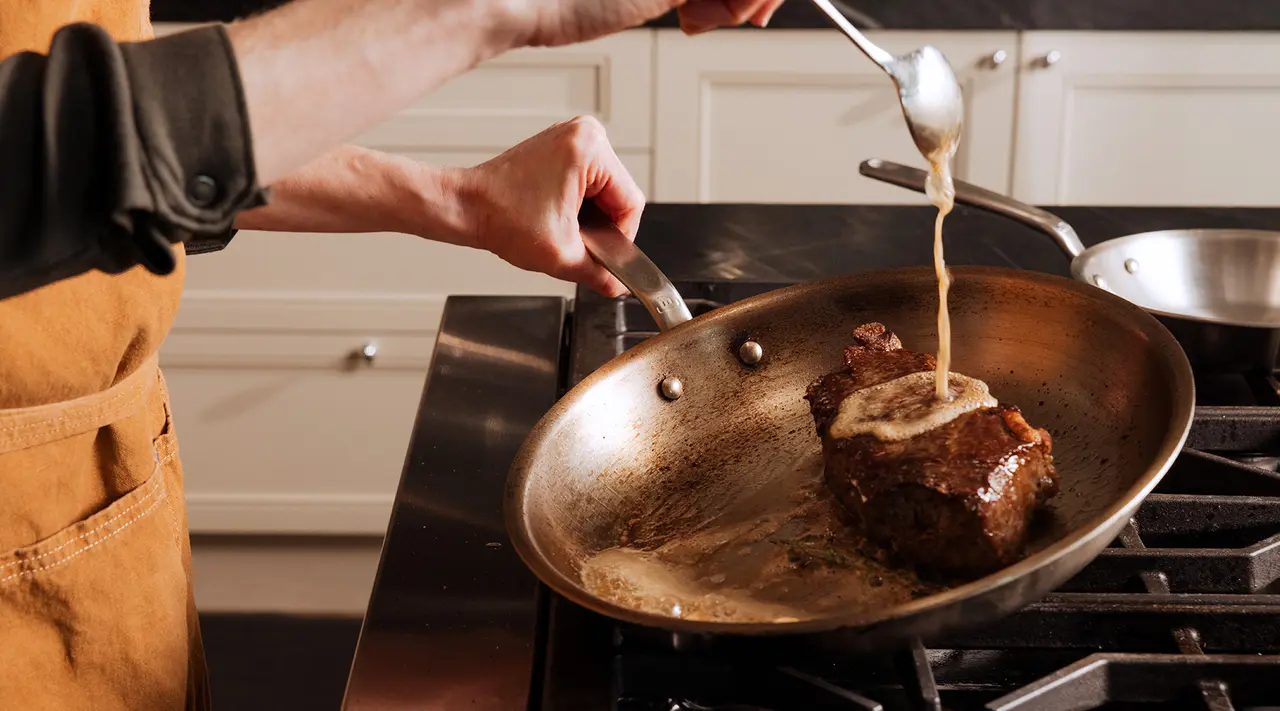Learn about different types of fats, their individual purposes, and why they’re essential to the cooking process.
When it comes to following a clean, healthy diet, everyone avoids fat at all costs. Butter, lard, oil—those delectable bacon drippings—they all pack on the unwanted calories, keeping us from our goal weights.
But once you find your way around the kitchen, it becomes abundantly clear: fats are a fundamental part of the cooking process. And beyond butter and oil, there are many different types of cooking fats that come together to create an entire culinary category.
So stop staring down a sea of products at the local grocery, and check out the following tips for choosing the right fat for the task at hand. Once you have a handle on things like smoking point, each variety’s distinct purpose, and why we love such rich, flavorful, fatty foods, you’ll be on your way to smarter—and healthier—cooking habits.
Why do we cook with fat?
When cooking meats, poultry, potatoes, eggs, and other common kitchen staples on the stovetop, it’s best to have a barrier between the food’s natural water source (which steams the meal) and the liquid in which you cook it. This is how deep-fried food comes out so utterly perfect every single time.
Whether you use olive oil, canola oil, vegetable oil, coconut oil—practically any slippery fat, the flavorful drippings take the place of the escaping water, thereby infusing food with that crisp, savory, succulent finish. This is all due to fat’s natural aversion to water. It separates itself away without worry, just like oil and vinegar.
Some like it hot
Whereas H2O dissipates under high heat, fats retain heat well, and at incredibly high temperatures in excess of 500°F. This is the only way to get a truly crispy, perfectly seared result. So for steaks, chops, fried chicken, french fries and other favorites, fat’s the only way to play.
As we all know, fat also provides much-needed lubrication in the pan, and it’s not by happenstance. By spraying on some oil or tossing in a slab of butter, the proteins in your food lose their ‘sticking’ ability. This molecular mixing helps you avoid messy, scrape-from-the-bottom eggs or a ruthlessly ripped up chicken breast.
What’s this about a ‘smoke point’?
Fat can withstand high cooking temperatures compared to water. Still, there's a line that—when crossed—turns your pan from a perfect boiling bath to a veritable fire hazard. That’s the ‘smoke point.’
Oils, lards and butters all withstand heat differently, so it’s important to know what temps your skillet or oven must reach for your meal to be cooked to completion. Whatever the recipe calls for, be sure to choose accordingly. Here’s a brief rundown:
- Safflower Oil: 510°F
- Refined Olive Oil: 465°F
- Clarified Butter & Peanut Oil: 450°F
- Vegetable & Canola Oil: 400°F
- Avocado Oil, Shortening: 360°F-375°F
- Butter, EVOO & Coconut Oil: 325-350°F
Notice that the more processed, refined and thereby ‘neutral’ the ingredient, the better it stands up to heat. This is due to the preparation process. Fats that are unrefined and cold-pressed still have their natural minerals and enzymes in tact, which produce exceptional flavor—but not-so-sensational heat tolerance.
The writing’s on the wall: for a cold, flavorful drizzle or cooking at lower temps, stick with unrefined oils. For a fantastic sear, go with a clarified butter or refined oil.
Final fatty thoughts
Throughout our research, we encountered some mixed thoughts on both the health implications and strategic uses of fats in cooking. What’s clear is that everything—including butters and oils—should be used in moderation.
If smoke is billowing from your skillet, it isn't exactly a ‘warning’ that your dish is destroyed, or that you’ve conjured up some cancer-causing curse upon your family. Consult with a dietician if you’re concerned about fatty intake, and most importantly, consider the right type of fat for the food you’re working with.
By considering smoking point, various flavor profiles and the cooking temps required for your recipe, you’ll have a firm handle on fat’s role in the contemporary kitchen.
Happy eating! And remember to sizzle responsibly.






























